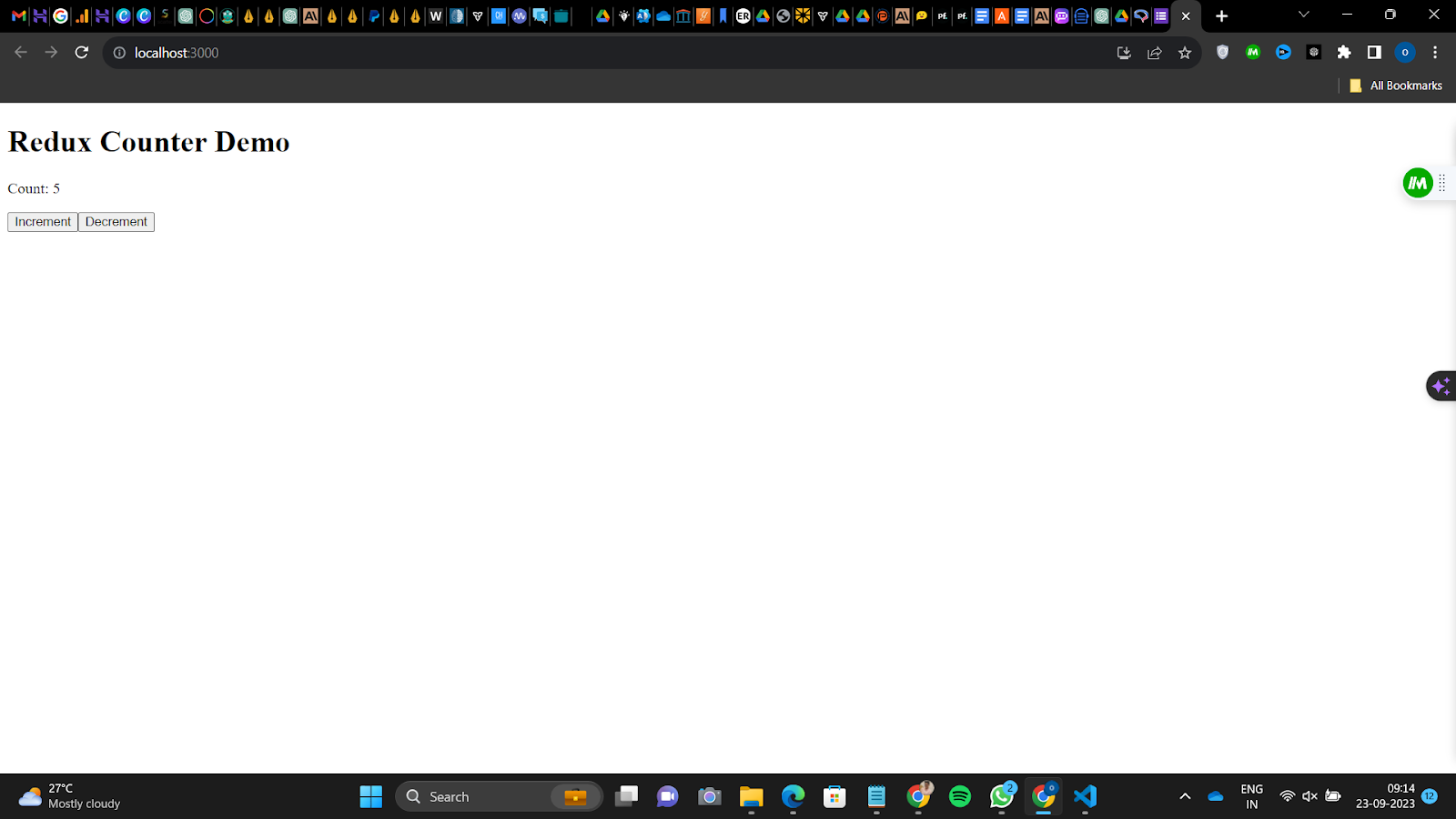Managing state in large React applications can quickly become complex. This is where Redux in React comes in. Redux provides a predictable way to manage application state by centralizing it in a single store. It enforces a unidirectional data flow and makes tracking state changes easier.
This tutorial on Redux in React will guide you through the core concepts of Redux, including stores, actions, and reducers. You will learn how to integrate Redux seamlessly into React applications using React Redux. By the end of this guide, you will be able to implement scalable state management in your React projects and simplify complex state interactions effectively.
Enter the forefront of software development. Learn the latest technologies, work on practical projects, and elevate your career with our expertly designed Software Engineering Courses.
What is Redux?
Redux is a predictable state container for JavaScript applications. It helps you write applications that behave consistently across client, server, and native environments and are easy to test.
Step into the next era of tech innovation. Master Cloud Computing, DevOps, and AI-driven Full-Stack Development with courses designed to equip you with practical skills for real-world success.
Redux revolves around a strict unidirectional data flow and central data store. This makes tracking changes and debugging easier.
The main concepts and components of Redux are:
- Store - Store is the single source of truth for the application state. It holds the entire app state in a tree structure.
- Actions - Plain objects describing intent to change state. For example, LOGIN_USER.
- Reducers - Pure functions taking state and actions as input and returning a new state. State mutations occur in reducers.
- Store methods - getState(), dispatch(action), and subscribe(listener) are the methods to interact with the store.
The Redux store calls the root reducer whenever an action is dispatched. The root reducer may combine the output of multiple reducers into a single state tree.
Must Read: What is React? A Complete Overview
Why Redux?
As React applications grow in scale, managing state across components can get difficult. Some of the problems faced are:
- Components that need the same state are located far apart in the component tree. Passing props down multiple levels is cumbersome.
- Certain components need access to multiple pieces of state. We end up passing a complex tangle of props around components.
- Shared state logic often gets duplicated across components when it needs to be updated.
Redux State Management
Without Redux, components that need the same data have to pass props down through multiple levels.
Redux solves this problem in the following ways:
- Providing a central store that holds the application state. Any component can access the state it needs directly from the store.
- State mutations happen through dispatched actions only. This makes tracking state changes predictable.
- The reducers that mutate state are pure functions without side effects. This makes debugging easier.
Overall, Redux makes state management scalable by lifting shared state out of React components into a global store. Components can access the state they need without prop drilling.
Must Read: Top 25+ JavaScript Frameworks to Learn in 2025 & How to Choose the Right One
Why Use React Redux?
While Redux can be used with any UI framework, it is most commonly used with React. Here are some of the benefits of using React Redux together:
- Seamless integration - React Redux integrates Redux with React apps smoothly with the <Provider> and connect() APIs.
- Preserves React principles - React Redux allows you to follow React principles like unidirectional data flow and separation of concerns.
- Efficient updates - It enhances the performance of React applications by avoiding re-rendering.
- Developer tools - React Redux was inspired by Redux DevTools. It comes with built-in functionality for debugging through time travel.
- Ease of use - The APIs of React Redux are user-friendly and straightforward for developers experienced in React.
- Large ecosystem - React Redux benefits from a community that provides documentation and a wide range of third-party libraries.
To put it simply, React Redux brings together the strengths of Redux, React and Redux DevTools to provide a way of managing state in React applications.
Principles of Redux
Redux follows three key principles that make application state management predictable, especially when considering redux in react native:
1. Single source of truth
The entire state of your app is stored in a single store. This makes it easy to track changes. The single state tree makes debugging easy as there are no multiple versions of the state spread across components.
2. State is read-only
The only way to change the state is by dispatching actions. Actions describe the intent to change state. Since actions are the only way to describe changes, debugging is easier.
3. Changes via pure functions
State changes happen through reducer functions. Reducers are pure functions. They take the previous state and return the next state. The output depends only on the input arguments.
Since reducers are pure functions without side effects, you can replay the actions and get the same state output every time. This makes debugging predictable.
Also Read: Packages in Java Programming – Concepts and Examples
Redux Architecture
Redux follows a unidirectional data flow model:
- A component dispatches an action when the user interacts with it. For example, clicking a Login button can trigger a LOGIN_REQUEST action.
- The Redux store calls the reducer function with the previous state and action as arguments. The reducer returns the next state.
- The store saves the complete state tree returned by the reducer. All subscribers are notified of the update.
- The component receives the updated state via props and re-renders with new data.
This pattern continues whenever the subsequent action is sent out. The action explains "what occurred" in your application while the reducer manages how the state is modified.
Redux Installation
Let's examine the steps involved in installing Redux and integrating it into a React application.
1. Create a React App
To begin, we can initiate a React project by utilizing the Create React App tool.
npx create-react-app my-app
cd my-app
2. Install Redux and React Redux
Next, we can proceed with installing the packages for Redux and React Redux from NPM.
npm install redux react-redux
3. Create Store
Next, we move forward with the creation of a file named src/store.js in order to establish and customize our Redux store.
import { createStore } from 'redux';
const store = createStore(() => {});
export default store;4. Set up Provider
We have to enclose the <App> component within the <Provider> in index.js. This enables components to establish a connection with the store.
ReactDOM.render(
<Provider store={store}>
<App />
</Provider>,
document.getElementById('root')
);
This feature enables all elements within the application to connect to the Redux store using the React Redux connect() API.
That's everything you need to do! Our React application is now linked with Redux. Moving forward, we will delve into examples to demonstrate how Redux functions in real-world scenarios.
Pros and Cons of Redux
Following are some of the key pros and cons of using Redux:
Pros
- Centralized app state makes debugging easy
- Writing predictable code by enforcing restrictions on when/how states can change
- Ease of tracing changes - Redux DevTools provides powerful debugging capabilities like time travel
- Works well with immutable data structures, which avoid mutation issues
- The ability to persist state-to-local storage allows for offline access
- Large ecosystem of ad-ons like middleware, DevTools, React bindings etc.
Cons
- More code for you to write - actions, reducers, constants
- More concepts for developers to learn - actions, reducers, store, middleware
- Overkill for small projects - more useful when managing complex state
- Boilerplate code for setup/installation. However, starter kits can help.
- Overall, Redux works very well for medium and large-scale apps. The benefits outweigh the extra code you have to write once the app's complexity grows.
Demo Application: React with Redux
1. Setup
npx create-react-app redux-counter-demo
cd redux-counter-demo |
2. Install Required Packages
npm install redux react-redux |
File Structure:
redux-counter-demo/
├── src/
│ ├── redux/
│ │ ├── actions.js # Action creators
│ │ ├── reducers.js # Reducer function(s)
│ │ └── store.js # Redux store
│ ├── App.js # Main React component
│ └── index.js # Entry point
└── package.json |
3. Redux Implementation:
actions.js:
export const increment = () => ({ type: 'INCREMENT' });
export const decrement = () => ({ type: 'DECREMENT' }); |
reducers.js:
const initialState = {
count: 0
};
function counterReducer(state = initialState, action) {
switch (action.type) {
case 'INCREMENT':
return { ...state, count: state.count + 1 };
case 'DECREMENT':
return { ...state, count: state.count - 1 };
default:
return state;
}
}
export default counterReducer; |
store.js:
import { createStore } from 'redux';
import counterReducer from './reducers';
const store = createStore(counterReducer);
export default store; |
React Components:
App.js:
import React from 'react';
import { useSelector, useDispatch } from 'react-redux';
import { increment, decrement } from './redux/actions';
function App() {
const count = useSelector(state => state.count);
const dispatch = useDispatch();
return (
<div className="App">
<h1>Redux Counter Demo</h1>
<p>Count: {count}</p>
<button onClick={() => dispatch(increment())}>Increment</button>
<button onClick={() => dispatch(decrement())}>Decrement</button>
</div>
);
}
export default App; |
index.js:
import React from 'react';
import ReactDOM from 'react-dom';
import App from './App';
import { Provider } from 'react-redux';
import store from './redux/store';
ReactDOM.render(
<Provider store={store}>
<App />
</Provider>,
document.getElementById('root')
); |
4. To run the application:
Output:

Conclusion
This tutorial on Redux in React offers a clear overview for beginners and experienced developers alike. Redux provides predictable state management with a single store, unidirectional data flow, and controlled state mutations. Core concepts like actions, reducers, and the store simplify state tracking and debugging.
React Redux integrates Redux seamlessly into React apps via <Provider> and connect(). While Redux requires more code, it excels in complex applications with shared state across components. Features like undo/redo, state persistence, and time-travel debugging make Redux in React a powerful tool for building scalable, data-intensive React applications.
FAQs
1. What is the difference between React context API and Redux?
The React context API provides an easier way to pass data down the component tree without prop drilling. However, it is more limited compared to Redux which offers capabilities like store subscriptions, middleware, time travel debugging etc. Context is useful for simple cases while Redux excels at complex state management.
2. How does Redux work with server-side rendering?
On the server, you create a store instance and preload it with state. The client creates a store using the same reducer and initial state. React Redux can setup synchronization between the stores.
3. What is the suitability of Redux for small apps?
Redux does require more code. For small apps where state is managed locally, Redux may be overkill. As your app grows, Redux helps avoid prop drilling and provides centralized state.
4. How does Redux compare to React's useReducer hook?
The useReducer hook allows using the reducer pattern locally in components. However, Redux provides additional capabilities like middleware, store subscriptions, and DevTools integration which useReducer does not.


-7f4b4f34e09d42bfa73b58f4a230cffa.webp&w=128&q=75)
-7f4b4f34e09d42bfa73b58f4a230cffa.webp&w=128&q=75)


























-ae8d039bbd2a41318308f8d26b52ac8f.svg)







